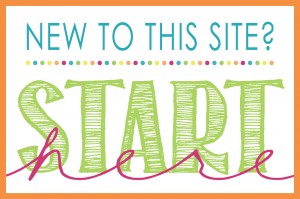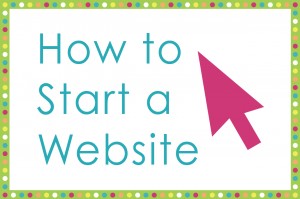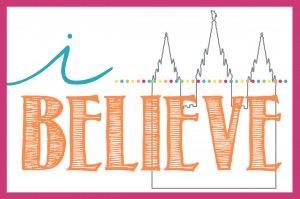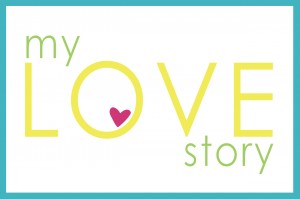I get asked the question all the time, “What camera should I buy?” Because I’ve had a professional grade camera body for quite a while now (Canon 5D), I don’t know a lot about the beginner models, so I’ve often deflected or given a very short answer. It’s just not a quick answer kind of deal. Well today, I’m going to help you figure out with a little Q&A, How to Decide What Camera to Buy.
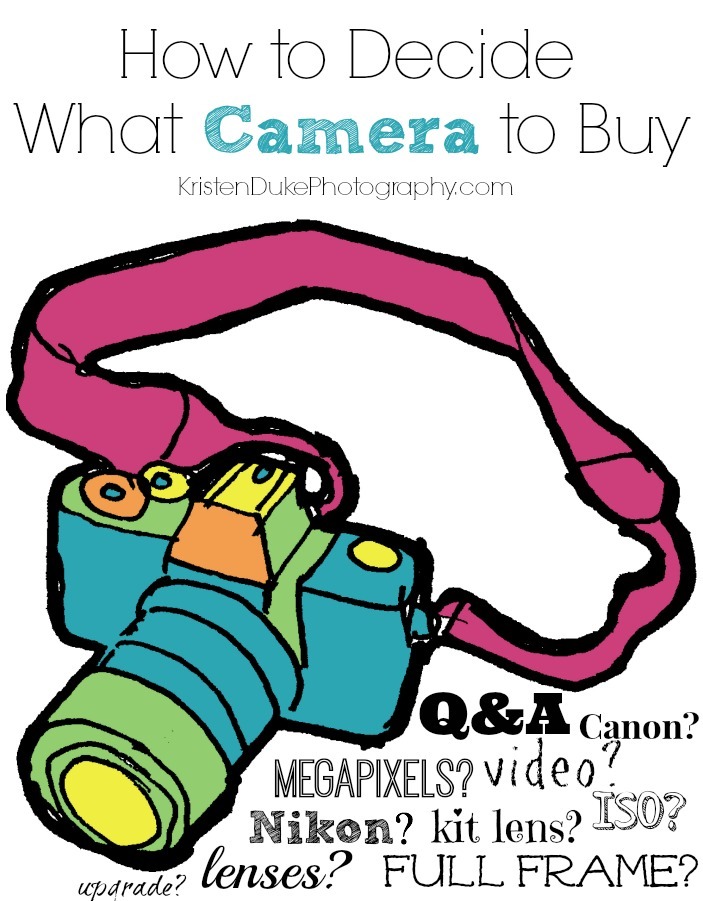
Let me give a personal disclosure that I have not held nor fiddled with all of these camera bodies. I am not PRO at the differences between different cameras/platforms, this is strictly MY OPINIONS as I’ve seen from friends and limited research.
If you’ve read my post, Inside my Camera Bag, you’ll know that I shoot on the Canon platform and have for 10 years. However, I see Nikon as equally fabulous, with the two brands leading the photography industry. Out of all of the professional photographers I know, I’ve found they either shoot Canon or Nikon.
What about Olympus? Sony? Pentax? They are likely great slr cameras as well, there just doesn’t seem to be the variety of lenses and support for those bodies. If you plan to expand your photography repertoire in the future, look into Canon or Nikon. If not, one of those brands will be fine. I’ve taught beginner workshops based off of my book, Say NO to Auto, and had people with all types of cameras attend. If the lenses can change, you can shoot in full manual no matter your model, so rest easy if you have one of those brands.
Lenses don’t work across platforms. I can’t put a Nikon lens on my Canon camera, so if you find you are lens shopping with an Olympus or Sony, there will be more limitations. There are generic brands such as Tamron, but you have to buy Tamron for Nikon or Tamron for Canon. I have a Tamron lens, but I’ve found the glass and crispness just isn’t there. But I was happy with it for a LONG time.
I shot with a Minolta film camera in high school and college, and when it came time to purchase my first digital camera, I felt overwhelmed with the options (even 10 years ago)! I was frustrated with the variety, and just wanted SOMEONE to pick one for me! I’m going to help you narrow down the options a little bit today.
Here are a few questions that will be helpful when you are searching for the right camera for you, something that will take you beyond basic snapshots—tiptoeing into beautiful photography.
What does SLR mean?
Single Lens Reflex. It’s a type of camera. It has interchangeable lenses. It’s fast! Some people will show me, or send me links of their cameras thinking they have an slr that they can shoot in full manual mode, but in fact, the lenses don’t change, so it is only partial manual. Generally the ISO and aperture can be changed, but not the shutter. The shutter comes in the SLR part.
Nikon or Canon?
Just pick one! Maybe your Auntie Josephine has a Canon so you go with that brand. Or you see Ashton Kutcher shoots with Nikon, so that must be the best. Or you’ve heard that Kristen Duke has had a Canon for 10 years, so it must be pretty FAB, go for it! Honestly, I almost switched to Nikon once because I liked the sound of the shutter–it’s different! Get a feel for both in your hands and just pick one.
Buy Just the Body or with Kit Lens?
Oh boy, this is a tough one for me. I’ll give you my input, then do what you want–it’s what you’ll end up doing anyway. I can relate to my medical husband when people come to him with an ailment, ask him what to do, he gives sound advice, but then they do what they want anyway which is against his advice.
If I could go back in time and tell the beginner “me” I would suggest purchasing JUST THE CAMERA BODY, and not get sucked into what a great deal the “kit” is. However, I know everyone is looking for a deal, and when you are buying an slr for the first time, you’ll will likely be peachy keen happy with the kit lens because you don’t know any different. You can still shoot on full manual, and will be pleased with your results. Eventually you’ll want to upgrade your lenses, and will kick the kit lens to the curb though. So, if you just want a quick deal, buy the body with the kit lens. You’ll either jump into photography looking for great images shooting on manual and realize it isn’t that great, or you’ll be thrilled with the results from the kit lens because it’s better than your phone. Either way, it’s no big deal. BUT, if you know from the get-go that you are determined to hone your photography art from the start, buy the body, and two lenses, which will be a bit more of an investment.
Which lenses?
Ok, so if you are going to take my advice and just buy the camera body, you’ll need a lens or two. The greatest advice any photographer ever gave me when I finally decided to take the leap and Say NO to Auto, was to suggest the 50mm 1.8 lens. That’s what I bought to replace my kit lens, and used it exclusively for TWO years for portraits for clients as well as my family at home. I mention that lens in my book, and several posts, because it’s an amazing little lens at just over $100. Inexpensive as far as photography equipment goes. (Nikons, make sure you get the one that has an auto focus switch on the lens, they sell a cheaper version without auto focus and I DO NOT shoot on manual FOCUS). I will say, the 50mm lens has it’s limitations though. It doesn’t zoom in and out–you are the zoom–and we just aren’t used to that. It’s a fixed lens, and in your home when you can’t back up because there is a wall there, that can be frustrating. But it also taught me that I prefer a cropped in picture anyway. So you can just get the 50mm lens with your camera body and be fairly satisfied. However, the only time I really wished I had more “wiggle room” in shooting was when I shot landscape or buildings. Because it’s so zoomed in, I couldn’t see the “big picture.” As well, and especially noticed it while traveling. For quite a while, I used the Tamron 28-75 lens, which I call my “all purpose” lens. It zooms in and out, and was what I often brought when traveling. But now, I just bring my fixed 35mm lens. I have a few options, but this has been great. The 35mm isn’t as versatile as the 28-75 but it’s clearer. I’ve got a lens comparison with examples in my Get Focused Intermediate book, but this is to just help you get started.
What about megapixels?
Then we hear about megapixels and frames per second and LCD screen sizes, and so many other specs that one seems to be better than the other, but how do you really know??? Let me tell you something about megapixels, in case you don’t already know….any SLR will have adequate megapixel size for most needs. Unless you are printing larger than a 16×20 (I don’t know people who do that unless they are pro’s), 12-18 megapixels is just great. It’s all about the image quality with LARGE prints, so if you aren’t in it to print billboard quality, you are just fine with the basic megapixel. It doesn’t mean that you will have “better” pictures than a camera body with fewer megapixels.
Would you like video with your camera?
This wasn’t an option for me with the beginner cameras years ago, but I think it’s SO great that it is, now. I have said recently, if it were me buying beginner, I’d get the most basic SLR that has video.
What is a full frame?
In more beginner level camera bodies, there is whats called a cropped frame. They work great, you won’t even realize what you are missing until you try a full frame. It’s a big deal for photographers, but full frame is not a need or deal breaker when buying a first camera, in my opinion. If you’ve had a cropped frame, and want to upgrade, you’ll notice a bit of a difference, but honestly, I didn’t notice much. My lenses that I already had just behaved differently from my cropped frame to my full frame.
Does ISO matter on the camera I buy?
In my opinion, when a photographer upgrades from one camera body to the next, a majority of the reason why is because of ISO capabilities. They want to capture the ambient light without using a flash, and can do so by cranking up their ISO to 2000 or more. If you aren’t sure yet what ISO is all about, check out my book, and you’ll come away understanding the exposure triangle better with ISO, aperture, and shutter speed and how they work together to give you the best picture. In a nutshell, beginner camera bodies aren’t equipped as well to handle darker lit situations, and even cranking up your ISO to 1000 or higher doesn’t help as much because the beginner camera body can’t handle a higher ISO as well as a more pro camera body. You will come away with grainy images, less crisp. If you are taking picture outside when the sun is out (in the shade–my favorite photography conditions) then you will be just fine with a lower ISO. And if you are inside and it’s dark, pop on an external flash and bounce the light, or a lightscoop to bounce the on camera flash. If it’s dark or night, I generally use a flash and bounce the light.
Video?
A lot of the newer made camera bodies have video included, too, so if you can–get that!! It at least helps narrow down the search!
Spend $500 or $5000?
This seems to be the toughest question of all. So many options, so many specs, how does one know? Of course everyone thinks that if you spend more, you’ll be getting a “better” camera, right? Maybe somewhere in-between is a good idea. Most of us upgrade from a pocket camera (or camera phone) because we want the ability to take FASTER pictures, without the delay. To capture the kids in motion, dancing, etc. The clarity on an SLR camera (even on AUTO) is much better than those little cameras (though phone cameras have come LONG way). So we start the research, knowing only this.
If you are a beginner, go for the basic model, you will be very happy! They seem to start at around $500 (older model), or going up to $800 (most current model). This would be a Canon Rebel T3i or a Nikon D5100. Model numbers will vary depending on how new they are. Your local shops like Best Buy will generally have the newest model, and you can at least look at and hold them. I buy online from Amazon, or I’m not afraid of Ebay or Craigslist for used, either because I like to save money and buy an older model. The differences are SO slim, but there is often $100 difference in price. If you buy used, you just gotta find out how long they’ve had the camera, and how many clicks it’s had taken. I would not buy a camera that a pro photographer is selling–it’s been overused! My first digital slr camera was the first Canon Rebel, and it was great for a few years.
If you have a beginner body and you want to upgrade, or you want to start at the intermediate level because you know you want to do more with your camera right from the beginning, you can look at the semi pro camera bodies such as the Canon 70D or the Nikon d80 which starts at around $1000 for the body only. I would say that if you have aspirations to start a photography business, to shoot with a mid level camera body such as these. It has a higher ISO capability. I shot with a 20D for several years, it was a more durable build, and had more of an ISO stretch than my Rebel, and even though you can do great things with a beginner camera, if you have any sort of business, the appearance of a “nicer” camera holds some water. You don’t want to have your clients telling you they have the same camera. Then again, if you rock the beginner camera, it can be kinda fun to show of how good you are!
I’ve been shooting with a more advanced camera for about 5 years now. I upgraded from my 20D to a Canon 5D which I used til it started to die. Just last month I got the Canon 5D Mark II (the Mark III is the latest and greatest, but I’m thrifty and get the old model once the new one comes out). I paid around $2000 for the body only (on ebay after a bid war, new, they are hard to find). The newest Mark III is $3k for the body only. Now that’s a LOT of money, and unless you are making money with photography via a business, I see no reason why you need to start with this–especially if it is your first camera. The Nikon equivalent is the D800.
If you are a pro, and want to get into major sports photography or become a National Geographic photographer, you my look into the Canon EOS 1DX or the Nikon D4s, but they sell for over $5000. They have the ability to shoot in burst mode, many many images in rapid succession. So you may want to start with another camera unless you won the lottery;)
Just Pick One!
It’s an investment to buy a camera, and a big deal, and I think people over think what to buy because there are so many options. Totally understandable–I was the same way! I hope this post helps you understand what is best for you, please don’t hesitate to ask questions in the comment if something doesn’t make sense!!
I linked to a few photography related posts within this post, but I’ve got lots more photo tips HERE.
Here is a glance at what is inside my camera bag from Amazon (affiliate links).
If you’d to join the Capturing Joy Photo Club on Facebook, where we have photo challenges, Q&A’s, and image sharing, request to join HERE: https://www.facebook.com/groups/CapturingJoyPhotoClub/



